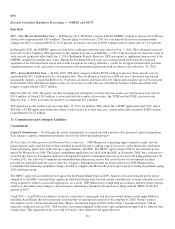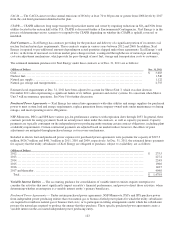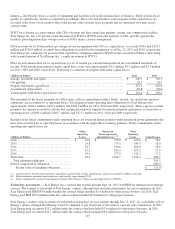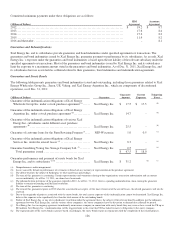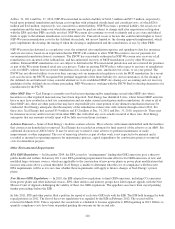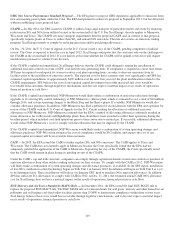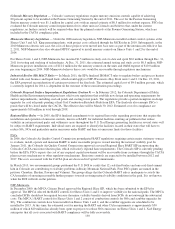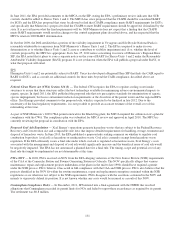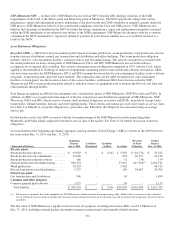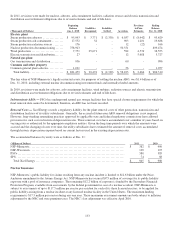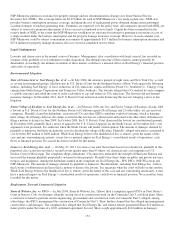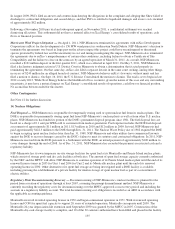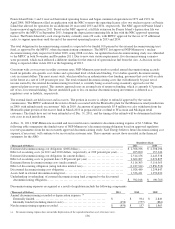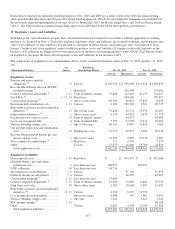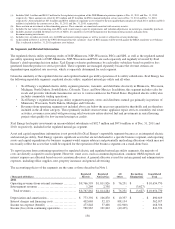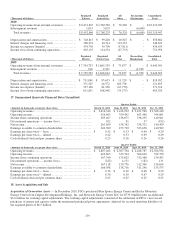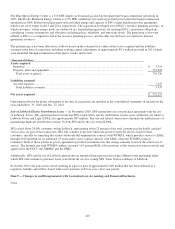Xcel Energy 2011 Annual Report Download - page 140
Download and view the complete annual report
Please find page 140 of the 2011 Xcel Energy annual report below. You can navigate through the pages in the report by either clicking on the pages listed below, or by using the keyword search tool below to find specific information within the annual report.
130
Colorado Mercury Regulation — Colorado’s mercury regulations require mercury emission controls capable of achieving
80 percent capture to be installed at the Pawnee Generating Station by the end of 2011. The cost for the Pawnee Generating
Station mercury controls was $1.1 million for capital costs with an annual estimate of $0.5 million for sorbent expense. PSCo has
evaluated the Colorado mercury control requirements for its other units in Colorado and believes that, under the current
regulations, no further controls will be required other than the planned controls at the Pawnee Generating Station, which are
included in the CACJA compliance plan.
Minnesota Mercury Legislation — Under the 2006 mercury legislation, NSP-Minnesota installed sorbent control systems at the
Sherco Unit 3 and A.S. King generating plants, with project costs collected through the MCR rider in 2010. Subsequently, in the
2010 Minnesota electric rate case, the costs of these projects were moved into base rates as part of the interim rates effective Jan.
2, 2011. NSP-Minnesota has also obtained MPUC approval to install mercury controls on Sherco Units 1 and 2 by the end of
2014.
For Sherco Units 1 and 2, NSP-Minnesota has incurred $1.5 million in study costs to date and spent $0.6 million through Dec. 31,
2011 for testing and studying of technologies. At Dec. 31, 2011, the estimated annual testing and study cost is $0.5 million. NSP-
Minnesota projects installation costs of $12.0 million for the mercury controls on the units and O&M expense of $10.0 million
per year beginning in 2014. NSP-Minnesota believes these costs would be recoverable through regulatory mechanisms.
Industrial Broiler (IB) MACT Rules — In March 2011, the EPA finalized IB MACT rules to regulate boilers and process heaters
fueled with coal, biomass and liquid fuels, which would apply to NSP-Wisconsin’s Bay Front units 1 and 2. On Dec. 23, 2011,
the EPA proposed reconsideration of certain provisions of the final rule. The estimated capital cost of $9.0 million per unit, which
is currently targeted for 2014, is dependent on the outcome of the reconsideration proceedings.
Colorado Proposed Surface Impoundment Regulations (Section 9) — In February 2012, the Colorado Department of Public
Health and the Environment promulgated new solid waste regulations that establish new design and operating requirements for
surface impoundments, including coal ash ponds and cooling tower ponds. The regulations provide a partial exemption on design
upgrades for coal ash ponds pending a final Coal Combustion Residuals Rule from EPA. The final rule also exempts PSCo’s
ponds that will be closed under the CACJA. The effective date will be March 30, 2012. Estimated costs for compliance are
approximately $18 million in total through 2018.
Regional Haze Rules — In 2005, the EPA finalized amendments to its regional haze rules regarding provisions that require the
installation and operation of emission controls, known as BART, for industrial facilities emitting air pollutants that reduce
visibility in certain national parks and wilderness areas throughout the U.S. Xcel Energy generating facilities in several states will
be subject to BART requirements. Individual states are required to identify the facilities located in their states that will have to
reduce SO2, NOx and particulate matter emissions under BART and then set emissions limits for those facilities.
PSCo
In 2006, the Colorado Air Quality Control Commission promulgated BART regulations requiring certain major stationary sources
to evaluate, install, operate and maintain BART to make reasonable progress toward meeting the national visibility goal. In
January 2011, the Colorado Air Quality Control Commission approved a revised Regional Haze BART SIP incorporating the
Colorado CACJA emission reduction plan, which will satisfy regional haze requirements. The Colorado SIP is currently pending
before the EPA. PSCo expects the cost of any required capital investment will be recoverable from customers through the CACJA
plan recovery mechanisms or other regulatory mechanisms. Emissions controls are expected to be installed between 2012 and
2017. The costs associated with the CACJA plan are discussed in Capital Commitments.
In March 2010, two environmental groups petitioned the U.S. DOI to certify that 12 coal-fired boilers and one coal-fired cement
kiln in Colorado are contributing to visibility problems in Rocky Mountain National Park. Four PSCo plants are named in the
petition: Cherokee, Hayden, Pawnee and Valmont. The groups allege that the Colorado BART rule is inadequate to satisfy the
CAA mandate of ensuring reasonable further progress towards restoring natural visibility conditions in the park. It is not known
when the DOI will rule on the petition.
NSP-Minnesota
In December 2009, the MPCA Citizens Board approved the Regional Haze SIP, which has been submitted to the EPA for
approval. The MPCA selected the BART controls for Sherco Units 1 and 2 to improve visibility in the national parks. The MPCA
concluded SCRs should not be required because the minor visibility benefits derived from SCRs do not outweigh the substantial
costs. The MPCA’s BART controls for Sherco Units 1 and 2 consist of combustion controls for NOx and scrubber upgrades for
SO2. The combustion controls have been installed on Sherco Units 1 and 2, and the scrubber upgrades are scheduled to be
installed by 2015. At this time, the estimated cost for meeting the BART and other CAA requirements is approximately $50
million of which $20 million has already been spent on projects to reduce NOx emissions on Sherco Units 1 and 2. Xcel Energy
anticipates that all costs associated with BART compliance will be fully recoverable.




